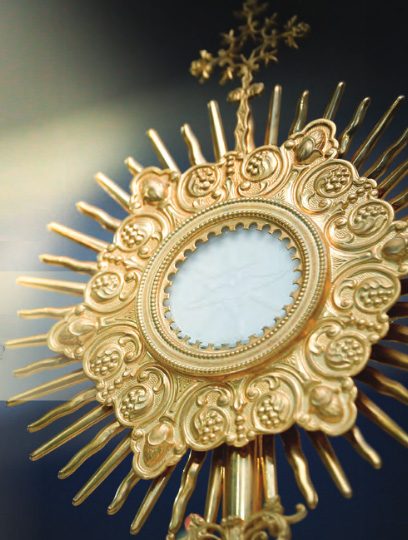
Eucharistic Adoration and Celebration
By Father David Renne, vice rector of St. Mark Seminary and an instructor of theology at Gannon University
11/06/2023
If Jesus said, “Take this, all of you, and eat of it, for this is my body,” and “Take this, all of you, and drink from it, for this is the chalice of my blood,” what is the point of eucharistic adoration? Wasn’t the eucharist instituted to be consumed, not adored?
 It is a false dichotomy to argue that the Eucharist was instituted to be consumed and not to be adored because Eucharistic devotions such as adoration and Eucharistic processions naturally flow out of the celebration of the Mass. Such devotions are meant to encourage sacramental reception by cultivating a deeper reverence and love for our Lord in the Eucharist. Although it is true that in the first centuries of Christianity the Eucharist was understood primarily as a sacrificial meal shared in the context of a faith community, Eucharistic devotions organically began to develop out of the Eucharistic liturgy itself. St. Augustine pointed out that “No one eats the flesh without first adoring it; we should sin were we not to adore it.” Similarly, in his 2007 apostolic exhortation, Sacramentum Caritatis, Pope Benedict XVI highlighted the intrinsic relationship between Eucharistic adoration and Eucharistic celebration.
It is a false dichotomy to argue that the Eucharist was instituted to be consumed and not to be adored because Eucharistic devotions such as adoration and Eucharistic processions naturally flow out of the celebration of the Mass. Such devotions are meant to encourage sacramental reception by cultivating a deeper reverence and love for our Lord in the Eucharist. Although it is true that in the first centuries of Christianity the Eucharist was understood primarily as a sacrificial meal shared in the context of a faith community, Eucharistic devotions organically began to develop out of the Eucharistic liturgy itself. St. Augustine pointed out that “No one eats the flesh without first adoring it; we should sin were we not to adore it.” Similarly, in his 2007 apostolic exhortation, Sacramentum Caritatis, Pope Benedict XVI highlighted the intrinsic relationship between Eucharistic adoration and Eucharistic celebration.
In the Eucharist, the Son of God comes to meet us and desires to be with us; Eucharistic adoration is simply the natural consequence of Eucharistic celebration, which is itself the church’s supreme act of adoration. Receiving the Eucharist means adoring him whom we receive.
Devotion attached to gazing at the sacred species began in the twelfth century within the context of the Mass. The devotion began at a time when conscious communal participation in the Mass had declined considerably and the sacramental reception of the Eucharist was infrequent among the laity. To emphasize the mysterious nature of the Eucharist, church interiors tended to obscure the ritual actions from the faithful, creating a sense of detachment between the priest and the people. The practice of elevating the host and eventually the chalice began to be introduced into the liturgy so that the sublime moment of consecration could be witnessed more clearly by everyone present. In an effort to prolong the elevation, the Eucharist began to be displayed outside of Mass in a monstrance. There was already an established devotion of displaying the relics of saints in ornate reliquaries. Because the Eucharist is truly the Body of Christ, it came to be recognized as the ultimate holy relic and the first monstrances were indistinguishable from the reliquaries used to display the relics of saints.
Eucharistic processions became popular in the thirteenth century with the addition of Corpus Christi to the universal church calendar. The feast began in the Belgian city of Liège around 1256, following the Eucharistic visions of Blessed Juliana of Liège (1192-1258). The first Eucharistic processions associated with Corpus Christi were intimately linked to the church’s liturgy. Pope Urban IV proposed special indulgences for those who attended matins, Mass and vespers on the feast, encouraging greater participation in both the Liturgy of the Hours and the Mass. The Council of Trent unwaveringly defended the Eucharistic devotions associated with the feast of Corpus Christi during which “this sublime and venerable sacrament” should be “hailed with particular veneration and solemnity and carried with reverence and honor in processions through streets and public places.”
Eucharistic devotions outside of Mass are always fruitful when they are understood within the context of the Eucharistic liturgy which is both their origin and goal. The beauty of any Eucharistic devotion outside of Mass is that it extends the sacred encounter that occurs at every Mass and invites those who gaze upon the Eucharist to be drawn deeper into the mystery. Theologian Paul McPartlan describes Eucharistic adoration as a “freeze-frame of the Eucharistic action” which enables the adorer to “reflect and marvel…only so as to plunge back into the mystery and receive, pressing on toward the true end that the Lord intends by this gift, namely the transformation of ourselves and the whole world.
”Eucharistic devotions outside of Mass are not individualistic private devotions, but rather are intended to lead to a deeper love for the church community that is continually built up through the celebration and reception of the Eucharist. The USCCB’s 2021 document, The Mystery of the Eucharist in the Life of the Church, acknowledges and encourages the recent resurgence in Eucharistic devotions outside of Mass, quoting Saint Mother Teresa of Calcutta who said, “When you look at the crucifix, you understand how much Jesus loved you then. When you look at the Sacred Host, you understand how much Jesus loves you now.” Let us pray that the many Eucharistic devotions promoted by our current Eucharistic revival may reveal Christ’s love to people everywhere in a profound way and enkindle a deeper desire to participate more fervently in the sacred liturgy.
-
